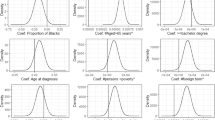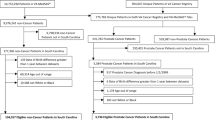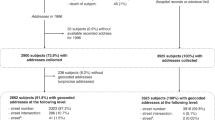Abstract
Prostate cancer is the most common cancer and the second leading cause of cancer-related deaths among men in the USA. In Virginia, which is a representative, ethnically diverse state of more than 8 million people that was established nearly 400 years ago, prostate cancer has the highest rate of new detection for any type of cancer. All men are at risk of developing prostate cancer regardless of demographics, but some men have an increased mortality risk due to cancer metastasis. Notably, one in five African American men will be diagnosed with prostate cancer in their lifetime and they have the highest prostate cancer mortality rate of any ethnic group in the USA, including Virginia. A person’s genetic profile and family history are important biological determinants of prostate cancer risk, but modifiable environmental factors (e.g., pollution) appear to be correlated with patterns of disease prevalence and risk. In this review, we examine current perspectives on population-level spatial patterns of prostate cancer in Virginia. For context, recent, publicly available data from the Centers for Disease Control and Prevention are highlighted and presented in spatial format. In addition, we explore possible co-morbidities of prostate cancer that may have demographic underpinnings highlighted in recent health disparity studies.


Similar content being viewed by others
References
Heaphy CM, Joshu CE, Barber JR, Davis C, Zarinshenas R, De Marzo AM, Lotan TL, Sfanos KS, Meeker AK, Platz EA. Racial difference in prostate cancer cell telomere lengths in men with higher grade prostate cancer: a clue to the racial disparity in prostate cancer outcomes. Cancer Epidemiology and Prevention Biomarkers. 2020;29(3):676–80.
Lynch SM, Sorice K, Tagai EK, Handorf EA. Use of empiric methods to inform prostate cancer health disparities:cComparison of neighborhood-wide association study “hits” in black and white men. Cancer. 2020;126(9):1949–57.
Newitt VN. Disparities among cancer patients seen in gaps in clinical trial participation. Oncology Times. 2020;42(3):1–11.
García-Pérez J, Pérez-Abad N, Lope V, Castelló A, Pollán M, González-Sánchez M, Valencia JL, López-Abente G, Fernández-Navarro P. Breast and prostate cancer mortality and industrial pollution. Environ Pollut. 2016;214:394–9.
Conrad CF, Chisholm-Brause CJ. Spatial survey of trace metal contaminants in the sediments of the Elizabeth River. Virginia Mar Pollut Bull. 2004;49(4):319–24.
Volkoff SJ, Osterberg JS, Jayasundara N. Embryonic Fundulus heteroclitus response to sediment extracts from differentially contaminated sites in the Elizabeth River. VA Ecotoxicology. 2019;28:1126–35.
Culp MB, Soerjomataram I, Efstathiou JA, Bray F, Jemal A. Recent global patterns in prostate cancer incidence and mortality rates. Eur Urol. 2020;77:38–52.
Pinsky PF, Miller E, Prorok P, Grubb R, Crawford ED, Andriole G. Extended follow-up for prostate cancer incidence and mortality among participants in the Prostate, Lung, Colorectal and Ovarian randomized cancer screening trial. BJU Int. 2019;123(5):854–60.
Gillessen S, Attard G, Beer TM, Beltran H, Bjartell A, Bossi A, Briganti A, Bristow RG, Chi KN, Clarke N, Davis ID. Management of patients with advanced prostate cancer: report of the advanced prostate cancer consensus conference 2019. Eur Urol. 2020;77(4):508–47.
Halwani AS, Rasmussen KM, Pati, V, Li CC, Yong CM, Burningham Z, Gupta S, Narayanan S, Lin SW, Carroll S, Mhatre SK. Real-world practice patterns in veterans with metastatic castration-resistant prostate cancer. Urologic Oncology: Seminars and Original Investigations 2020;38(1);1e1–1e10.
Goodman PJ, Tangen CM, Darke AK, Lucia MS, Ford LG, Minasian LM, Parnes HL, LeBlanc ML, Thompson IM. Long-term effects of finasteride on prostate cancer mortality. N Engl J Med. 2019;380(4):393–4.
Wagland R, Nayoan J, Matheson L, Rivas C, Brett J, Collaco N, Alexis O, Gavin A, Glaser AW, Watson E. Adjustment strategies amongst black African and black Caribbean men following treatment for prostate cancer: Findings from the Life After Prostate Cancer Diagnosis (LAPCD) study. Eur J Cancer Care. 2020;29(1);e13183.
Gilbert SM, Pow-Sang JM, Xiao H. Geographical factors associated with health disparity in prostate cancer. Cancer Control. 2016;23(4):401–8.
DeRouen MC, Schupp CW, Koo J, Yang J, Hertz A, Shariff-Marco S, Cockburn M, Nelson DO, Ingles SA, John EM, Gomez SL. Impact of individual and neighborhood factors on disparities in prostate cancer survival. Cancer Epidemiol. 2018;53:1–11.
Rogers CR, Blackburn BE, Huntington M, Curtin K, Thorpe RJ, Rowe K, Snyder J, Deshmukh V, Newman M, Fraser A, Smith K. Rural–urban disparities in colorectal cancer survival and risk among men in Utah: a statewide population-based study. Cancer Causes Control. 2020;31(3):241–53.
Grubich A, Makarevich VI, Zhukova OM. Description of spatial patterns of radionuclide deposition by lognormal distribution and hot spots. J Environ Radioact. 2013;126:264–72.
Sahar L, Foster SL, Sherman RL, Henry KA, Goldberg DW, Stinchcomb DG, Bauer JE. GIScience and cancer: state of the art and trends for cancer surveillance and epidemiology. Cancer. 2019;125(15):2544–60.
Swift A, Liu L, Uber J. Reducing MAUP bias of correlation statistics between water quality and GI illness. Comput Environ Urban Syst. 2008;32(2):134–48.
Wang M, Chi G, Bodovski Y, Holder SL, Lengerich EJ, Wasserman E, McDonald AC. Temporal and spatial trends and determinants of aggressive prostate cancer among Black and White men with prostate cancer. Cancer Causes Control. 2020;31(1):63–71.
Khang L, Adams SA, Steck SE, Zhang J, Xirasagar S, Daguise VG. Travel distance to screening facilities and completion of abnormal mammary follow-up among disadvantaged women. Ann Epidemiol. 2017;27:35–41.
Hurley SE, Saunders TM, Nivas R, Hertz A, Reynolds P. Post office box addresses: a challenge for geographic information system-based studies. Epidemiology. 2003:386–91.
Rytkönen MJ. Not all maps are equal: GIS and spatial analysis in epidemiology. Int J Circumpolar Health. 2004;63(1):9–24.
Walker G. Environmental justice: Concepts, evidence, and politics. Routledge; 2012.
Maantay J. Mapping environmental injustices: pitfalls and potential of geographic information systems in assessing environmental health and equity. Environ Health Perspect. 2002;110(suppl 2):161–71.
Myles P, Evans S, Lophatananon A, Dimitropoulou P, Easton D, Key T, Pocock R, Dearnaley D, Guy M, Edwards S, O'brien L. Diagnostic radiation procedures and risk of prostate cancer. British J Cancer 2008:98(11);1852–56.
Abhishek A, Singh V, Sinha RJ, Ansari NG, Siddiqe MKJ, Verma M, Kumar M. To study the relationship between cadmium, zinc and mtDNA copy number in North Indian patients suffering from prostate cancer: a case control study. Afr J Urol. 2017;23(2):126–32.
Yanan Z, McDermott S, Davis B, Hussey J. High incidence of brain and other nervous system cancer identified in two mining counties, 2001–2015. Spatial and Spatio-Temporal Epidemiology. 2020;32:100320.
Liu Y, Tang M, Zhou Z, Shi H, Lu J. Advances in molecular mechanisms of heavy metal induced cell malignant transformation. Cancer Reports and Reviews. 2018;2(2):1–4.
Safi R, Nelson ER, Chitneni SK, Franz KJ, George DJ, Zalutsky MR, McDonnell DP. Copper signaling axis as a target for prostate cancer therapeutics. Can Res. 2014;74(20):5819–31.
Donato MD, Cernera G, Giovannelli P, Galasso G, Bilancio A, Migliaccio A, Castoria G. Recent advances on bisphenol-A and endocrine disruptor effects on human prostate cancer. Mol Cell Endocrinol. 2017;457:35–42.
Canaz E, Kelinc M, Sayar H, Kiran G, Ozyurek E. Lead, selenium, and nickel concentrations in epithelial ovarian cancer, borderline ovarian tumor, and healthy ovarian tissues. J Trace Elem Med Biol. 2017;43:217–23.
Lim J, Nam C, Yang J, Rha KH, Lim K-M, Jee SH. Serum persistent organic pollutants (POPs) and prostate cancer risk: a case-cohort study. Int J Hyg Environ Health. 2017;220(5):849–56.
Khalid T, Aggio R, White P, De Lacy Costello B, Persad R, Al-Kateb H, Jones P, Probert CS, Ratcliffe, N. Urinary volatile organic compounds for the detection of prostate cancer. PloS One. 2015;10(11):e0143283.
Deng Y, Wang M, Tian T, Lin S, Xu P, Zhou L, Dai C, Hao Q, Wu Y, Zhai Z, Zhu Y. The effect of hexavalent chromium on the incidence and mortality of human cancers: a meta-analysis based on published epidemiological cohort studies. Front Oncol. 2019;9:24.
He Y, Du Z, Ma S, Cheng S, Jiang S, Liu Y, Li D, Huang H, Zhang K, Zheng X. Biosynthesis, antibacterial activity and anticancer effects against prostate cancer (PC-3) cells of silver nanoparticles using Dimocarpus Longan Lour. peel extract. Nanoscale Res Let. 2016;11(1):1–10.
Band PR, Abanto Z, Bert J, Lang B, Fang R, Gallagher RP, Le ND. Prostate cancer risk and exposure to pesticides in British Columbia Farmers. Prostate. 2010;71(2):169–83.
Parrón T, Requena M, Hernández AF, Alarcón R. Environmental exposure to pesticides and cancer risk in multiple human organ systems. Toxicol Lett. 2014;230(2):157–65.
Cressy D. Debate rages over herbicide’s cancer risk. Nature News. 2015;13Nov.
Davoren M, Schiertl R. Glyphosate-based herbicides and cancer risk: a part-IARC decision review of potential mechanisms policy and avenue of research. Carcinogenesis. 2018;39(10):1207–15.
Karimi G, Shahar S, Homayouni N, Rajikan R, Bakar NFA, Othman MS. Association between trace elements and heavy metal levels in hair and nail with prostate cancer. Asian Pac J Cancer Prev. 2012;13(9):4249–53.
Chandrasekaran B, Dahiya NR, Tyagi A, Kolluru V, Saran U, Baby BV, States JC, Haddad AQ, Ankem MK, Damodaran C. Chronic exposure to cadmium induces a malignant transformation of benign prostate epithelial cells. Oncogenesis. 2020;9(2):1–10.
Gomes LS, Costa JR, Campos MS, Marques MR, Biancardi MF, Taboga SR, Ghedini PC, Santos FC. Aluminum disrupts the prenatal development of the male and female gerbil prostate (Meriones unguiculatus). Exp Mol Pathol. 2019;107:32–42.
Zhang C, Li P, Wen Y, Feng G, Liu Y, Zhang Y, Xu Y, Zhang Z. The promotion on cell growth of androgen-dependent prostate cancer by antimony via mimicking androgen activity. Toxicol Lett. 2018;288:136–42.
Layne TM, Graubard BI, Ma X, Mayne ST. Albanes D Prostate cancer risk factors in black and white men in the NIH-AARP Diet and Health Study. Prostate Cancer Prostatic Dis. 2019;22(1):91–100.
Rivadeneira NA, Hoskote M, Le GM, Nguyen TT, Nápoles AM, Pasick RJ, Sarkar U. Hiatt RA Advancing cancer control in San Francisco: cancer screening in under-represented populations. Am J Prev Med. 2020;58(1):e1–9.
Idan E, Xing A, Ivory J, Alsan M. Sociodemographic correlates of medical mistrust among African American men living in the East Bay. J Health Care Poor Underserved. 2020;31(1):115–27.
Rawla P. Epidemiology of prostate cancer. World J Oncol. 2019;10(2):63–89.
Preston MA, Gerke T, Carlsson SV, Signorello L, Sjoberg DD, Markt SC, Kibel AS, Trinh QD, Steinwandel M, Blot W, Vickers AJ. Baseline prostate-specific antigen level in midlife and aggressive prostate cancer in black men. Eur Urol. 2019;75(3):399–407.
McCray N, Thompson L, Branch F, Porter N, Peterson J, Perry MJ. Talking about public health with African American men: perceptions of environmental health and infertility. Am J Mens Health. 2020;14(1):1557988320901375.
Tolksdorf J, Kattan MW, Boorjian SA, Freedland SJ, Saba K, Poyet C, Guerrios L, De Hoedt A, Liss MA, Leach RJ, Hernandez J. Multi-cohort modeling strategies for scalable globally accessible prostate cancer risk tools. BMC Med Res Methodol. 2019;19(1):1–11.
Fujita K, Hayashi T, Matsushita M, Uemura M, Nonomura N. Obesity, inflammation, and prostate cancer. J Clin Med. 2019;8(2):201.
Greenberg S, Slager S, Neil BO, Cooney K, Maughan B, Stopa N, Venne V, Zickmund S, Colonna S. What men want: qualitative analysis of what men with prostate cancer (PCa) want to learn regarding genetic referral, counseling, and testing. Prostate. 2020;80(5):441–50.
Acknowledgements
We thank Dr. Luisel Ricks-Santi for assistance with obtaining publicly available registry data used in the assembly of this manuscript, as well as for conceptual input during the planning phases of this project.
Funding
Funding support was provided in part by the National Institute on Minority Health and Health Disparities (Award-U54MD008621, Subaward-190004 to EAL) and the National Science Foundation (HRD-1911928 to EAL; HRD-2000211 to CAB).
Author information
Authors and Affiliations
Corresponding authors
Ethics declarations
Ethics Approval
This review article included spatial analyses of data that are publicly available through the Centers for Disease Control and Prevention. The Institutional Review Board (IRB) at Hampton University determined that this project falls under “exempt category 4” and not subject to further ethical approval.
Conflict of Interest
All authors certify that they have no affiliations with or involvement in any organization or entity with any financial interest or non-financial interest in the subject matter or materials discussed in this manuscript.
Human and Animals Rights and Informed Consent
This article does not contain any studies with human or animal subjects performed by any of the authors.
Editorial Board Members and Editors
Author AJvW is the editor-in-chief, and authors CBL and EAL are section editors, of Current Molecular Biology Reports.
Additional information
Publisher's Note
Springer Nature remains neutral with regard to jurisdictional claims in published maps and institutional affiliations.
This article is part of Topical Collection on Molecular Biology of Cell Death and Aging
Rights and permissions
About this article
Cite this article
Adebola, T.M., Fennell, H.W.W., Druitt, M.D. et al. Population-level Patterns of Prostate Cancer Occurrence: Disparities in Virginia. Curr Mol Bio Rep 8, 1–8 (2022). https://doi.org/10.1007/s40610-022-00147-w
Accepted:
Published:
Issue Date:
DOI: https://doi.org/10.1007/s40610-022-00147-w




